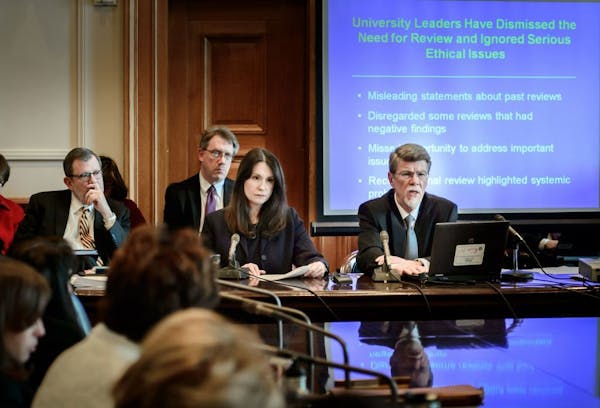Tom and Kristi Kuder began to notice dramatic changes in their son's behavior in 11th grade.
Previously a straight-A student, he lost focus on his schoolwork and spent hours alone in his room with the shades drawn. He filled notebooks with nonsensical messages and drawings. Perhaps most disturbing was the labyrinth of electrical wires that he stretched across his room, enabling him to activate lights, stereos and doors from his bed.
"We kept wondering: Is this just a kid with a creative mind, or is this a mental illness?" said Kristi Kuder.
Across the state, parents like the Kuders are about to get some long overdue support. After years of grass roots lobbying by such advocacy groups as the National Alliance on Mental Illness (NAMI), the 2015 Legislature approved funding for an innovative program that offers early detection and treatment of psychosis in young people. The goal is to reach young patients before their mental illness advances to a profound and harder-to-treat stage.
While the funding is modest — $1 million through 2019 — the impact could be far-reaching by calling attention to a problem that often goes untreated. State officials estimate that 1,500 youth in Minnesota have an initial episode of psychosis each year.
Through local grants, the state hopes to create a network of early outreach and psychosis prevention programs in areas of the state with high concentrations of youth homelessness, suicides and poverty. The initiative will be modeled on a highly successful program at the University of Minnesota that is considered pioneering for its engagement of family members.
"I'm hoping this is a game changer," assistant Human Services Commissioner Jennifer DeCubellis said in an interview. "It's small dollars now, but it enables us to show that … life trajectories can be turned in the opposite direction."
74 weeks untreated
Psychosis is notoriously difficult to detect early in its onset. Often, it surfaces in early adolescence with disorganized thinking and memory problems. Without treatment, a young person can descend into delusion and isolation, making their condition less manageable. Many lose their ability to focus on school or work. Often, the symptoms go untreated until a young person is hospitalized.
In a study to be published later this year, the National Institute of Mental Health found that people ages 15 to 40 who experience their first episode of psychosis go a median of 74 weeks without treatment.
"Often families are unsure of what to do," said Dr. John Kane, chairman of the Psychiatry Department at Zucker Hillside Hospital in Glen Oaks, N.Y., and principal investigator of the study. "They see something is wrong, but they don't necessarily feel they should bring their loved one to see a psychiatrist."
Dr. Michael O'Sullivan is well aware of these challenges. Since 2009, the U psychiatrist has overseen an intensive treatment program that has quietly helped more than 300 young people experiencing the early onset of psychosis. Many of the patients are referred from private hospitals across the state.
Unlike most psychiatric clinics, which focus on diagnosing a condition and prescribing drugs, the U's program emphasizes building trust among parents, doctors and the patients. In addition to attending therapy with their children, parents take eight weeks of classes on the symptoms of psychosis and how to intervene effectively.
Oregon's success
On a frigid evening last March, about two dozen parents crowded into a second-floor conference room at the U's Psychiatry Department. As the evening wore on, parents gradually shed their coats and sweaters and began opening up about the often perplexing behavior of their children. Many of the parents' questions focused on how to converse with young adults who had begun speaking in confused or elliptical language.
"Should we tell them when they're no longer making sense?" one parent asked.
"Try not to be judgmental," cautioned O'Sullivan, as the parents scribbled notes. "If you saw someone with a broken leg who was limping, you would probably not say, 'Stop limping!' " He encouraged parents to have their children repeat information back to them, even when it didn't appear to make sense.
The Kuders said they have given up looking for a "cure" for their son, who is now 27 and is diagnosed with schizoaffective disorder. But they attended the U program because they are still searching for new ideas and ways to relate to their son.
"With other physical ailments, there's a pretty clear scenario — you have pain, and here are some remedies," Tom Kuder said. "But with psychosis, there is a lot of fumbling around, … and the lack of clarity is the scariest thing. You never know what's going to happen next."
The U program is too new to track long-term effects, but the experience of another state suggests that intensive, early treatment works.
The state of Oregon has the nation's most expansive early psychosis intervention and treatment program, with community drop-in clinics and outreach programs in 32 of its 36 counties. Hospitalization rates among young people fell from 42 percent to 11 percent three months after they entered the program; and to a mere 3 percent within two years after enrollment, state data shows.
"It's tragic to see someone cut down in the prime of their life when it's not necessary," said Tamara Sale, director of the Early Assessment and Support Alliance (EASA) in Oregon. "If there's one thing we've learned, it's that if young people get help early on, the chances of them getting well is actually quite good."
Chris Serres • 612-673-4308
Twitter: @chrisserres

Biden scores endorsements from Kennedy family, looking to shore up support against Trump and RFK Jr.
The Latest | Seated juror in hush money trial excused as prosecutors ask judge to sanction Trump
Vice President Harris returning to Wisconsin for third visit this year
Former Wisconsin Democratic Rep. Peter Barca announces new bid for Congress

